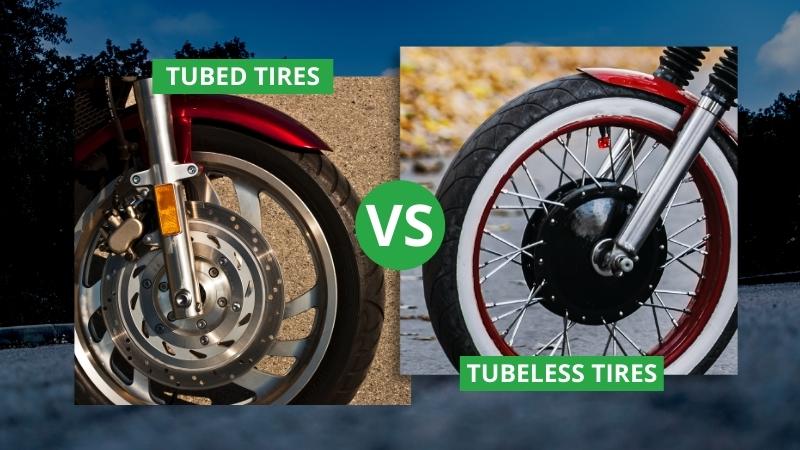If you don’t own a bike, motorcycle, or any other similar vehicle, you must have at least seen one.
And as you know, these vehicles use tires, or rather wheels, to move. The tires must be inflated to the required rate for these vehicles to move comfortably. Therefore, this post will look at the two types of tires used.
The two types of bike or motorcycle tires (larger vehicles like cars and trucks etc. almost never use tubed tires anymore) are designed differently and have different applications and advantages.
Tubed tires are designed to work with a separate inner air-holding component (tube) that holds the air, while tubeless tires are made to be airtight without a tube by being “self-sealed” against the rim by the air pressure itself.
Continue reading for more info about these two tire types.
What Are Tubed Tires?
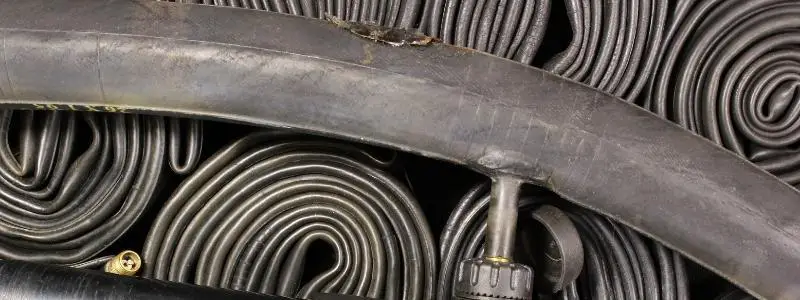
Tubed tires uses a separate inner air-holding item called a tube which when inflated puts pressure on the outer rubber, i.e. the tire that’s in contact with the ground.
The tube is flexible and soft so that it can fit inside the tire, while the outside of a tire should be strong enough to withstand miles of riding. Therefore, the tire uses two types of rubber for two different tasks.
What Are Tubeless Tires?
Tubeless tires are built with multiple ribs that are molded integrally into the bead of the tire (the part of the tire that has contact with the rim), when the tire becomes pressurized by air (or Nitrogen) the tire will then seal with the flanges of the rim, holding the pressure inside.
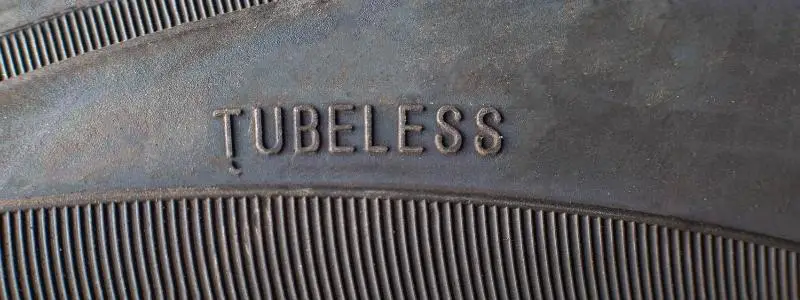
Tubeless tires provide some significant benefits compared to tubed tires. They are lightweight and run cooler, because there are no friction between two rubbers, as is the case with tubed tires.
Moreover, they handle punctures better. If a tubed tire captures a nail or any other sharp object at 90 mph, the tube deflates instantly, causing the tire to collapse.
On the other hand, a tubeless tire can take a nail, screw, or any pointy object but does not deflate instantly. Instead, the tire seals around the object using the sealant to maintain the air inside and deflates at a very low rate to allow you to get off the road safely.
One concern regarding a flat tire is how to repair it. If you are standing by the side of a busy road with a deflated tire, it is much easier to fix a tubeless tire. You only need to have a way to reinflate your tire and a plug kit, and then you get back on your way.
For a tubed tire, you must remove the wheel from your vehicle to take the tube out, replace the tube or patch the hole, then reassemble the tire and inflate it. It is doable, but it requires many steps as you must find a way to raise your vehicle for wheel removal.
Difference Between Tubed And Tubeless Tires
Both tires have different applications and advantages. Below is a table showing the common differences between these two tire types.
| Parameters | Tubeless Tire | Tubed Tire |
| Traction | More traction with the ground due to less weight | Less traction with the ground due to more weight |
| Comfort | Highly comfortable | Less comfortable |
| Fuel efficiency | More fuel efficient due to light weight | Less fuel efficient due to heavy weight |
| Weight | Lighter than tubed tires | Heavier than tubeless tires |
| Maintenance | Less maintenance needed since chances of puncture are low | High maintenance needed since chances of puncture are high |
| Cost | More costly | Less costly |
| Repair process | Easy and simple since there is no need to remove the wheel | It is complicated as it involves removing the wheel from the vehicle, then removing the tube and reassembling them. |
| Durability | More durable since no tube is placed in them | More prone to punctures due to the tubes placed in them |
Pros of Tubed Tires
Tubed tires are faster and easier to set up: installing a new tube and tire requires little practice. You don’t need to get a seal or mess up with a sealant. To install a tube is just a matter of a few minutes.
Running tubes is cheaper: if you need to install a new tube, there is no need to worry about getting any new parts. Tubes will always work harmoniously with the existing rim and tire. It is also very cheap to buy spare tubes and patches. A new tube would cost you a few coins. A patch kit goes for about $5.
Tubes and patches are available anywhere in the world: even in the most remote areas, you can still get a replacement tube. It may not be one of the best qualities, but it will help you continue your journey.
A tube repair kit is small and light: all you require to repair a flat tire are tire levers, a spare tube, and a patch kit. You don’t need to carry a sewing kit, plugs, sealant, or super glue.
Patching a tube is easy: repairing a tube is an easy process that almost everyone knows. If you can’t do it yourself, find someone around to do it. Few people know how to repair them if you need assistance with tubeless tires. All rims and tires are designed to use tubes.
Cons of Tubed Tires
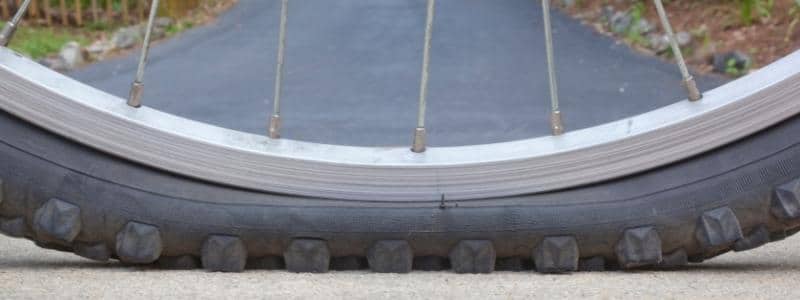
You’ll ride slower with tubes: since you cannot run with low-pressure tires, it is also hard to take turns fast. If you do so, you risk the tire washing out. Additionally, climbing fast is a challenge as the tire can spin out.
You’ll get a lot more flats: getting flat is the biggest challenge with tubes. A shard of glass or tiny staples can puncture your tube. If you drive in areas where thorns are common, getting flat is daily with tubes.
Handling is hard with tubes: traction is not as required since you can’t run tubes at low pressure. This is because most of the tire is not in contact with the road surface. For this reason, most bike, motorcycle, and car owners do not use tubes.
Tubes are heavier: a tube increases the weight of your tire by about 200 grams. Lightweight wheels do not require much energy to accelerate.
Tubes are outdated: if you like to get the newest model of items, then a tube is not your perfect match. Tubeless tires are the latest in town and are a bit lighter.
Pros of Tubeless Tires
More Durable: tubeless tires are more durable as there is no flimsy tube. Also, the absence of a tube means the tire has to be made of strong material. Therefore, tubeless tires last longer than tubed tires.
Extended retention of pressure: tubeless tires are the best to prevent punctures. They provide better resistance when pierced as they do not lose pressure easily like tubed tires. The valve remains complete also. The air comes out at a low rate allowing you to drive for some distance or arrive at a place to have the puncture repaired.
Less sensitive to pressure fluctuations: the tubeless tire is not affected by temperature changes due to the fact that it does not use the fragile tube that could pop.
More fuel-efficient: Their lightweight properties bring fuel efficiency in tubeless tires.
Better heat dissipation: there is increased heat dissipation as direct contact between the air and the rim. This helps in cooling the wheel, which heats up with time. In tubed tires, the friction between the tire and the tube causes overheating, damaging the tube.
Lightweight: the tire is light as there is no inner tube. This enhances the fuel economy drive quality and experience as the rolling resistance is decreased.
More comfortable and safe at high speed: since tubeless tires do not deflate suddenly, they are much safer at high speeds as the absence of a tube reduces the chances of accidents from tire busts and loss of control.
Cons of Tubeless Tires
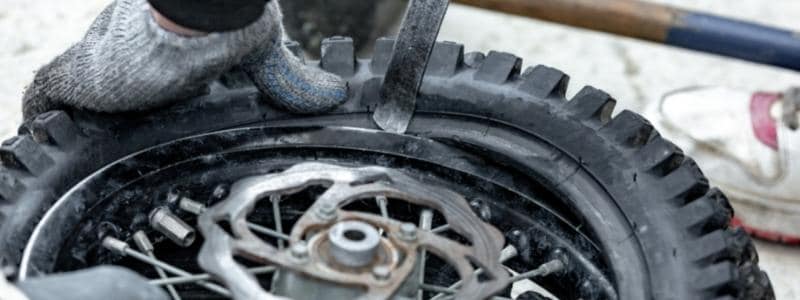
Tubeless tires are more expensive: tubeless wheels and tires are more costly to buy than those made to use tubes. If your existing gear cannot be converted to tubeless, you should buy a new one. This adds several small costs when switching to tubeless. Additionally, you will require a tubeless patch kit.
It is a bit tedious and time-wasting to fix a tubeless tire: the most challenging part is to ensure that the tire beat rests properly on the rim. This involves trial and error that may take minutes, if not hours. When it is set, you must add a lot of compressed air quickly. If there is a leakage, you must take everything apart to repair it.
More maintenance is required: the sealant may dry up with time or leak out in case of a puncture. Once per season, you should top up the sealant to ensure enough to seal the tire in the event of a puncture.
Tubeless gear is hard to get: finding tubeless sealant, patches, or rim tape in remote regions may be daunting. Most small repair parts shops do not stock tubeless gear. Therefore, you either bring your own or switch to tubes.
You need a high-volume pump: when setting up tubeless, you should quickly pump compressed air into the tire to have the bead seal appropriately. A mini pump may not make it.
Valves get clogged up: the sealant used during setup can coagulate, and when it dries can clog your valves. However, you can remove the valve and clean it to get the blockage out.
Burping happens when the tire and the bead brakes separate from the rim. The tire might deflate, and the sealant spray all over. This is common when running low tire pressure then hitting a sharp rock.
Why Choose One Instead of The Other?
The main reason to choose tubeless tires is safety and overall functionality. The tires handle punctures by forming a slight seal around the pinning object and allowing air to escape slowly. On the other hand, tubed tires are the best for off-road.
Is it OK to Put a Tube in a Tubeless Tire?
Yes, although it can be dangerous. First of all, check if anything obstructs the wheel’s surface, such as a loose label inside the tire. Another thing to consider is the tire’s load rating and speed rating. This should be one speed, and one load less than the tubeless tire can handle.
Final Thoughts
Though preference over style is different from one person to another, the tubeless tire is the best choice.
From the pros and cons of both tubed and tubeless tires, it is evident that tubeless tires have many benefits that their counterparts don’t have. Therefore, I recommend you go for a brand that won’t subject you to risks. With tubeless tires, sudden deflation is a thing of the past.
Hi, my name is Niklas, the head content creator & CEO of Whirling Wheelz. I am very interested in vehicles of all kinds, mainly cars. I have a car mechanics degree from high school and a big hobby of mine is to follow the WRC (World Rally Championship) both online and through travel.

